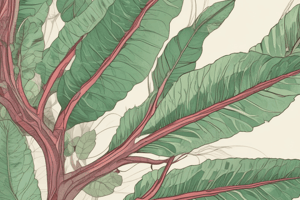Podcast
Questions and Answers
What is the primary function of vascular tissue in plants?
What is the primary function of vascular tissue in plants?
- Photosynthesis and energy production
- Water and food transportation (correct)
- Protection against pathogens
- Support and structural integrity
What are the two types of conducting tissues that make up the vascular tissue system?
What are the two types of conducting tissues that make up the vascular tissue system?
- Phloem and Sclerenchyma
- Xylem and Epidermis
- Collenchyma and Sclerenchyma
- Xylem and Phloem (correct)
What type of plants are characterized by the presence of vascular tissues?
What type of plants are characterized by the presence of vascular tissues?
- Mosses and liverworts
- Ferns, angiosperms, and gymnosperms (correct)
- Bryophytes and pteridophytes
- Algae and fungi
What is the arrangement of cells that gives rise to vascular tissue in plants?
What is the arrangement of cells that gives rise to vascular tissue in plants?
What is the purpose of xylem in vascular tissue?
What is the purpose of xylem in vascular tissue?
What is the primary function of the xylem tissue in plants?
What is the primary function of the xylem tissue in plants?
Which of the following is NOT a component of secondary xylem?
Which of the following is NOT a component of secondary xylem?
What is the primary mechanism by which plants lose water?
What is the primary mechanism by which plants lose water?
What is the purpose of phloem tissue in plants?
What is the purpose of phloem tissue in plants?
Why is it essential to replace water lost through transpiration in plants?
Why is it essential to replace water lost through transpiration in plants?
What is the characteristic of cells in the xylem?
What is the characteristic of cells in the xylem?
What is the primary function of companion cells in phloem?
What is the primary function of companion cells in phloem?
What is the arrangement of the vascular bundle in the roots of monocotyledons?
What is the arrangement of the vascular bundle in the roots of monocotyledons?
What is produced by the vascular cambium?
What is produced by the vascular cambium?
What is the characteristic of the secondary xylem?
What is the characteristic of the secondary xylem?
Flashcards are hidden until you start studying
Study Notes
Vascular Tissue in Plants Overview
- Vascular tissue is a vital tissue in plants responsible for water and food transportation.
- It is composed of arranged groups of cells that form a tissue system, which extends to every organ in the plant.
- The vascular tissue connects water intake and food synthesis sites to plants' cell growth, development, and storage regions.
Types of Vascular Tissue
- Xylem is responsible for water and mineral salts conduction.
- Phloem transports dissolved food substances in the plants.
- Both xylem and phloem are complex tissues in plants.
Xylem
- Primary xylem is present in young developing plants, but as the plants grow, secondary xylem is formed.
- Secondary xylem comprises five components: rays, tracheid, vessels, xylem parenchyma, and xylem fibers.
- Xylem transports water and mineral salts from the roots to the entire plant.
- Water loss occurs through stomata, cuticle, and lenticels, with the majority of water loss through stomata.
Phloem
- Phloem transports metabolites such as sugars, amino acids, and other organic substances from the site of their production to other plant organs.
- The components making up the phloem are sieve tubes, companion cells, fibers, and parenchyma cells.
- Phloem is responsible for translocation, which is the transportation of soluble organic substances within the plant.
Vascular Tissue Function
- Vascular tissues are essential for plant survival.
- Xylem tissue is responsible for water and mineral salts transportation, involving several forces, including cohesion, adhesion, capillarity attraction, transpiration pull, and root pressure.
- Transpiration is beneficial in cooling the plants during hot weather, but excessive transpiration leads to wilting and eventually plant death.
- Phloem is responsible for translocation, which occurs through the sieve tubes.
Structure of Vascular Tissue
- Xylem cells include:
- Xylem fibers, which form wood and are strengthened with lignin.
- Xylem parenchyma, which form the packaging tissues and are found between vessels.
- Tracheid, which have perforated cross-walls with tapering end walls and are dead at maturity.
- Phloem cells include:
- Sieve cells, which are elongated and tapered in shape and conduct food elements in gymnosperms.
- Strasburger cells, which are elongated in shape and deliver substances such as ATP to sieve cells.
- Sieve-tube elements, which are also elongated and transport food substances in angiosperms.
- Companion cells, which are elongated in shape and have large nuclei and many mitochondria, and deliver food substances to sieve-tube elements.
Monocots vs Dicots Vascular Tissue
- The vascular bundle is continuous from roots to stems and leaves in both monocots and dicots.
- The vascular cambium produces both the secondary phloem and xylem.
- The secondary xylem is more complex than the primary xylem, especially in angiosperms, and is responsible for lateral growth.
- The arrangement of the vascular bundle in the roots and stems differs between monocots and dicots.
Studying That Suits You
Use AI to generate personalized quizzes and flashcards to suit your learning preferences.




